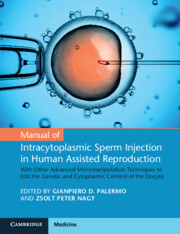 Manual of Intracytoplasmic Sperm Injection in Human Assisted Reproduction
Manual of Intracytoplasmic Sperm Injection in Human Assisted Reproduction Published online by Cambridge University Press: 02 December 2021
It is generally accepted that the presence of a presumably normal spermatozoon does not guarantee oocyte activation and fertilization, with some ICSI cycles constantly facing low fertilization if not complete fertilization failure. Both the sperm and the oocyte play an important role in oocyte activation and in case of physiological activation problems any artificial increase in ooplasmic calcium could rescue fertilization (irrespective of the causative gamete). Such an artificial Ca2+ increase can be achieved using modified ICSI techniques, piezoelectrical manipulation or chemical stimuli. Among these approaches the latter is currently the most accepted in IVF laboratories around the world, and the Ca2+-ionophores calcimycin and ionomycin are among the most extensively studied substances. Available neonatal and neurodevelopmental data indicate that ionophores can be considered safe, which may explain the steadily growing range of indications for application. However, as artificial oocyte activation rarely results in physiological Ca2+ oscillations and is not beneficial for all patients with a suspected activation deficiency, these techniques should not be used without profound indication.
To save this book to your Kindle, first ensure [email protected] is added to your Approved Personal Document E-mail List under your Personal Document Settings on the Manage Your Content and Devices page of your Amazon account. Then enter the ‘name’ part of your Kindle email address below. Find out more about saving to your Kindle.
Note you can select to save to either the @free.kindle.com or @kindle.com variations. ‘@free.kindle.com’ emails are free but can only be saved to your device when it is connected to wi-fi. ‘@kindle.com’ emails can be delivered even when you are not connected to wi-fi, but note that service fees apply.
Find out more about the Kindle Personal Document Service.
To save content items to your account, please confirm that you agree to abide by our usage policies. If this is the first time you use this feature, you will be asked to authorise Cambridge Core to connect with your account. Find out more about saving content to Dropbox.
To save content items to your account, please confirm that you agree to abide by our usage policies. If this is the first time you use this feature, you will be asked to authorise Cambridge Core to connect with your account. Find out more about saving content to Google Drive.